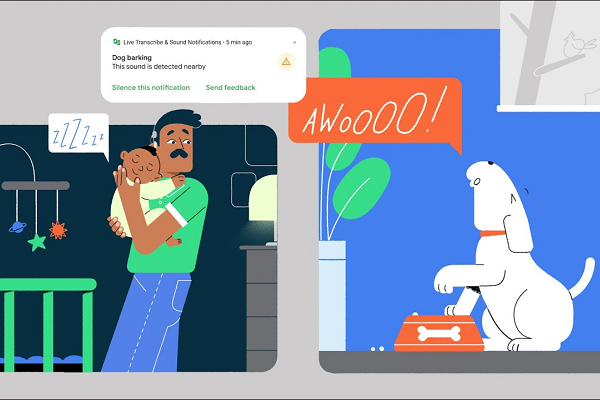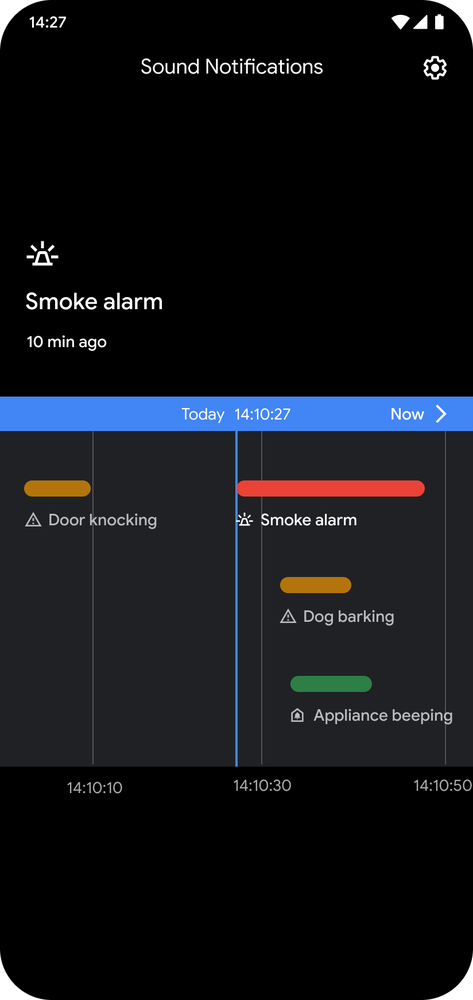New Android Accessibility Feature Alerts You to the Sounds You Don’t Hear
 Android devices will let their owners know if its microphones pick up the sound of a child crying, dog barking, or faucet running. The new Sound Notifications accessibility feature is designed to keep those who may be unable to hear those noises apprised of the situation around them. It’s the latest element of Google’s promotion of accessible tech during International Augmentative and Alternative Communication (AAC) Awareness Month.
Android devices will let their owners know if its microphones pick up the sound of a child crying, dog barking, or faucet running. The new Sound Notifications accessibility feature is designed to keep those who may be unable to hear those noises apprised of the situation around them. It’s the latest element of Google’s promotion of accessible tech during International Augmentative and Alternative Communication (AAC) Awareness Month.
Sound Notifications
When Sound Notifications are activated manually in the settings menu, the Android device’s microphone turns on and listens for any of the ten “critical sounds” Google has designated as alert-worthy. The noises include alarms, appliances beeping, people knocking on the door, and the aforementioned children and dogs. The detection, analysis, alerts, and timeline report all happen on the device, without any need for the cloud. Sound Notifications serve to attract the user’s attention with an alert like you might get for a text message, with different options available depending on if its on a phone or a smartwatch. The watch option is especially useful for when someone with hearing impairment is asleep.
Sound Notifications performs almost a reverse of the noise-canceling technology Google added to the Meet messaging platform, which also detects extraneous sounds, but deliberately edits them out from the exchange. The real-time alerts of those noises are also collected into a timeline for the user to look through, spotting when alerts are sent. That way, the user can see how they may be related. For instance, in the timeline to the side, it looks like a smoke alarm caused a dog to start barking, and may be related to the appliance that began beeping soon after.
“Designed for the estimated 466 million people in the world with hearing loss, Sound Notifications makes important and critical household sounds more accessible with push notifications, a flash from your camera light, or vibrations on your Android phone,” Google AI product manager Sagar Savla and Android accessibility product manager Sharlene Yuan wrote in a blog post about Sound Notifications. “This feature can also be helpful if someone is unable to hear temporarily as a result of an injury, wearing earplugs or headphones.”
Accessibility and Security
For AAC Awareness Month, Google has a whole line up of accessibility improvements. Last week, the company added eye-tracking controls to Google Assistant and upgraded Action Blocks to make the voice assistant and Android devices easier for people with disabilities to use. Google’s pitch for Sound Notifications as a tool specifically for those with hearing loss or who might be wearing headphones fits with the other accessibility tech, especially as it runs on the same software used for Android’s Live Transcribe accessibility feature. Live Transcribe uses the camera and microphone in a device to identify and describe the sights and sounds of the nearby environment for users with vision or hearing impairment.
However, the notifications make Sound Notifications more reminiscent of Nest Aware’s security feature that analyzes sounds detected by smart home devices and sends an alert to the owner’s phone if it detects sounds that may cause concern like a smoke alarm or the sound of glass breaking. Users who aren’t home can listen to the clip and decide whether to call 911 right from the Google Home app, ensuring the emergency services sent are close to their home, where they are at the moment. Google recently announced a $450 million investment and technical partnership with home security provider ADT, making it clear that applying AI to noise detection for security purposes will be an important part of the company’s future. On the other hand, Nest Aware relies on collecting and sharing audio and video through the cloud, unlike the purely local Sound Notifications. Theoretically, Sound Notifications would still work even if the device is in Ambient Mode, which turns a smartphone’s lock screen into a kind of limited smart display, including alerts. At the same time, it is plugged in and charging.
Follow @voicebotai Follow @erichschwartz
Google Rolls Out Action Blocks and Other New Android Accessibility Features
Google Nest Aware Adds Suspicious Sound Alerts, Drops Subscription and Device Prices
Google Invests $450M in ADT to Begin Smart Home Security Partnership








